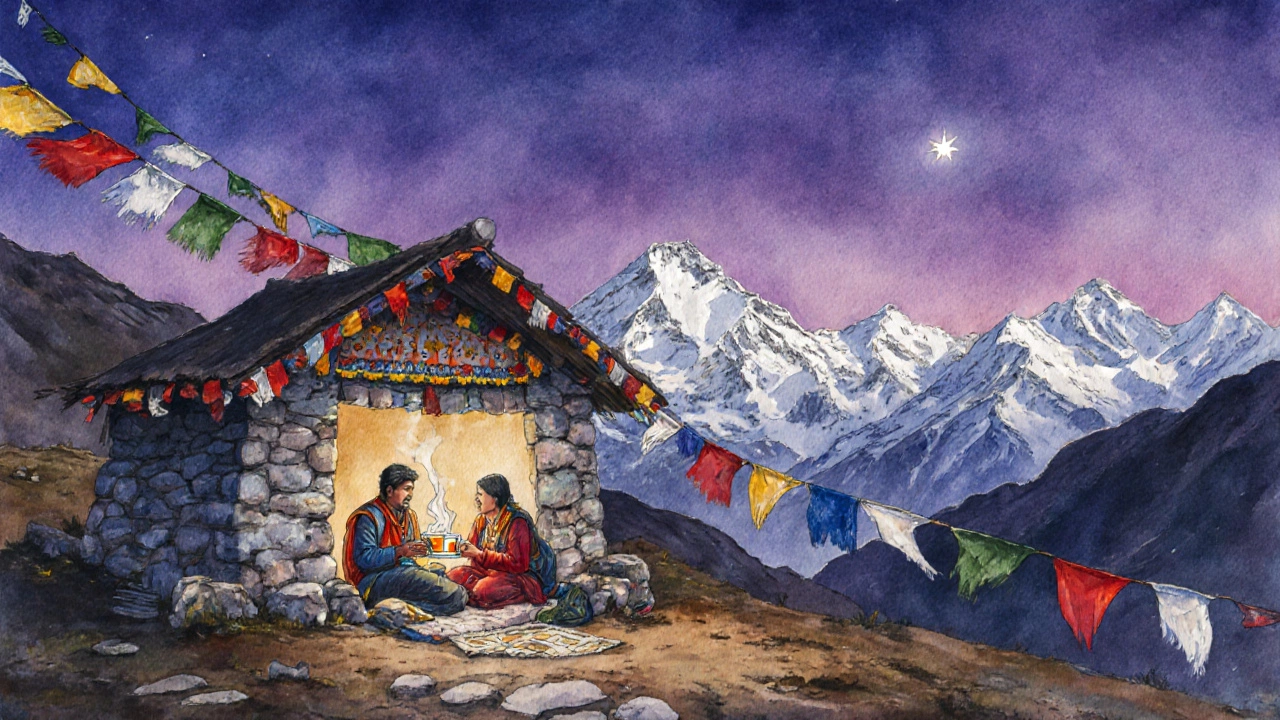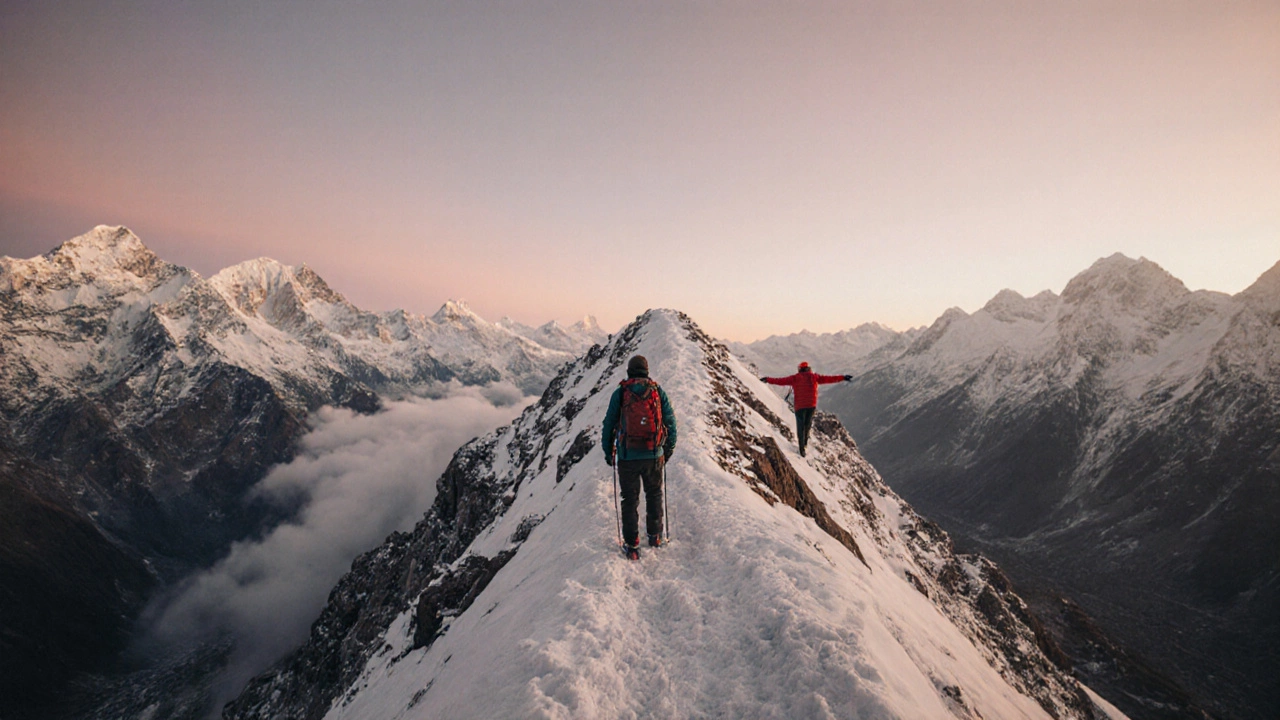Trekking Cost & Safety Calculator
Trek Details
Your Experience Level
Cost Estimate
Important Safety Note
Based on your input, this trek requires a guide in most cases. The article states: "Not every trek in India requires a guide. But some are non-negotiable." Solo trekkers face higher risk of getting lost, altitude sickness, and being turned away from villages. Cost savings from going solo aren't worth the danger.
Critical Safety Check
Essential Packing List
India isn’t just about temples and tuk-tuks. It’s got some of the most dramatic, diverse, and demanding trekking routes on Earth. From the snow-capped peaks of the Himalayas to the misty hills of the Western Ghats, the trails here don’t just test your legs-they change how you see the world. But here’s the truth: trek in India without a guide, and you might end up lost, sick, or worse. Not because the trails are impossible, but because the risks are real-and often hidden.
Why a Guide Isn’t Just Helpful, It’s Necessary
You can hike the Inca Trail without a guide. You can walk the Appalachian Trail solo. But trek in India? It’s different. The terrain doesn’t just change with altitude-it changes with culture, language, and local rules. A trail that looks like a gentle path on Google Maps might be closed due to a landslip, a religious procession, or a military zone you didn’t know existed. Locals know these things. A guide doesn’t just carry your pack-they carry the knowledge. In the Garhwal region, for example, the Valley of Flowers trail opens only from late June to early September. Outside that window, snow blocks the path and rivers swell beyond crossing. A guide knows the exact window. They know which guesthouses are open, which villages serve hot meals, and which routes are safest after monsoon rains. Without that, you’re guessing.What a Good Guide Actually Does
A guide isn’t just a person who walks ahead. A good guide is your navigator, medic, translator, and safety net-all in one. Here’s what they handle:- Route planning based on current weather and trail conditions
- Permit acquisition (many treks like Roopkund or Kedarkantha require official papers)
- Altitude sickness monitoring and emergency response
- Communication with village hosts and porters
- Carrying emergency gear: oxygen, first-aid kits, satellite phones
Where You Absolutely Need a Guide
Not every trek in India requires a guide. But some are non-negotiable:- Roopkund - Known as the “Skeleton Lake,” this 5-day trek reaches 5,000 meters. The final climb is icy and exposed. Landslides are common. Only licensed operators are allowed to take groups here.
- Markha Valley (Ladakh) - High altitude, remote, and culturally sensitive. Permits are required, and villages rely on tourism income. Independent trekkers often get turned away at checkpoints.
- Hampta Pass - The trail crosses a high-altitude pass with unpredictable weather. In 2024, three solo trekkers were rescued after hypothermia set in. All had skipped hiring a guide.
- Kedarkantha - Popular but dangerous in winter. Snowfall can erase trails overnight. Guides carry GPS trackers and know the safest snow crossings.

What Happens When You Go Solo
I’ve talked to dozens of trekkers who thought they could handle India on their own. Most came back with stories of getting lost, running out of water, or being turned away from guesthouses because they didn’t have the right permit. One woman from Australia trekked to Kuari Pass alone in October. She didn’t realize the trail was closed for the season. She spent three nights sleeping in a temple courtyard, waiting for a local guide to find her. India’s remote trails aren’t like Europe’s marked paths. There’s no signage in English. No trail maps you can download. No cell service beyond the first village. If you get hurt, no one will hear your scream. A guide carries a satellite device. You? You’re just another name on a missing persons list.How to Choose the Right Guide or Operator
Not all guides are created equal. Some are just locals with a walking stick. Others are trained in wilderness first aid, speak multiple languages, and have years of experience on the same trails. Look for these signs:- Registered with the Indian Mountaineering Foundation (IMF) - This is the official body. Check their website for licensed operators.
- Local community ties - The best guides come from the villages along the trail. They know the land because they grew up on it.
- Transparent pricing - Avoid operators who charge $10/day. That’s not a bargain-it’s exploitation. A fair price includes food, permits, gear, and fair wages for porters.
- Small group sizes - Groups over 8 people are harder to manage safely. Look for 4-6 person max.
Costs and What You’re Paying For
A guided trek in India costs between $30 and $100 per day, depending on the region and duration. That’s not expensive when you break it down:- Permits: $15-$50 (paid by the operator)
- Food and accommodation: $10-$20/day
- Porter wages: $8-$12/day (fair pay matters)
- Guide salary: $15-$25/day (certified guides earn more)
- Emergency gear and insurance: $5-$10/day

What to Pack Even If You Have a Guide
Your guide carries the big stuff. But you still need your own essentials:- Water purifier (bottled water is rare beyond towns)
- Headlamp with extra batteries
- Quick-dry clothing (cotton kills at altitude)
- High-SPF sunscreen and lip balm
- Basic first-aid kit: painkillers, anti-diarrheal, blister pads
- Power bank (solar chargers work better at altitude)
When You Can Skip a Guide
There are a few treks where solo travel is possible-if you’re experienced and prepared:- Nag Tibba - A 2-day trek near Mussoorie. Well-marked, low altitude. Only go in summer.
- Dayara Bugyal - Grassland trail in Uttarakhand. Popular with Indian families. Safe in June-October.
- Bhrigu Lake - Short, scenic, and often done as a day hike from Manali. Still, check weather before you go.
Final Thought: Respect the Mountain
India’s mountains aren’t backdrops for Instagram photos. They’re sacred. They’re alive. They change without warning. A guide doesn’t just keep you alive-they help you understand why you’re there. They teach you to listen to the wind, to read the clouds, to honor the land. You don’t need to be an expert to trek in India. But you do need to be humble. Hire a guide. Listen to them. Let them lead. The mountains don’t care how fit you are. They only care if you’re prepared.Is it safe to trek in India without a guide?
It’s risky. While a few low-altitude treks like Nag Tibba can be done solo, most trails in India-especially in the Himalayas-require permits, involve extreme weather, and have no cell service. Without a guide, you’re vulnerable to altitude sickness, getting lost, or being turned away from villages. In 2024, over 120 rescue operations were conducted on Indian treks, mostly involving solo travelers.
How much does a guided trek in India cost?
Prices range from $30 to $100 per day, depending on the trek’s difficulty and location. This includes permits, food, accommodation, porter wages, and guide fees. Avoid operators charging under $25/day-they’re likely underpaying staff or cutting safety corners.
Do I need a permit to trek in India?
Yes, for most major treks. Roopkund, Kedarkantha, Markha Valley, and Hampta Pass all require permits issued by the Indian Mountaineering Foundation or local forest departments. Only registered guides can legally apply for these. Trying to get them yourself is nearly impossible without local contacts.
What’s the best time to trek in India?
April to June and September to November are ideal. Monsoon (July-August) brings landslides. Winter (December-February) is too snowy for most trails except high-altitude ones like Chadar. Avoid trekking during major religious festivals-many trails close temporarily.
Can I hire a guide locally or should I book in advance?
You can hire guides in towns like Manali, Rishikesh, or Gangotri-but booking in advance ensures you get a certified, experienced guide with proper gear. Last-minute hires may not have permits, emergency equipment, or reliable communication tools. For popular treks like Roopkund, book 2-3 months ahead.
